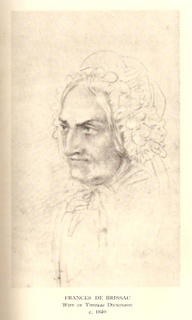 This
picture appears in Time and Chance of Frances de Brissac.
This
picture appears in Time and Chance of Frances de Brissac.
Joan Evans on Frances de Brissac.
Time and Chance - The story of Arthur Evans and his forebears
by Joan Evans Chapter 2 page 17 (Longmans published 1943)
In 1798, the Dickinson family took a cottage in the country for the summer. In a
letter from Fanny Burney, Madame d’Arblay the novelist, we read –
“One new acquaintance we have found it impossible to avoid….is now inhabited by
a large family from the city, of the name of Dickinson……. Mr Dickinson, or
Captain Dickinson, as his name-card says is very shy, but seems a sensible man,
and his lady is open, chatty, fond of her children, and anxious to accomplish
them. She seems between thirty and forty, and very lively. She is of French
origin, though born here, and of parents immediately English; but her
grandfather was a M.de Brissac.”
Page 19
Thomas Dickinson’s mother, Alice, had died some years before, and his father had
married as his second wife a Mrs Bernard. Both by birth – her maiden name was
Lardent – and her first marriage, she belonged to that curious and interesting
community of Huguenot refugees that had its centre in Spitalfields. The Their
forebears had come over from France in the years following the revocation of the
Edict of Nantes in 1685; they had become naturalized in England, yet their
descendants still formed a foreign
community. Through his stepmother Thomas Dickinson found himself admitted to
that closed society; a society with the intelligence that accompanies the easy
use of two languages, with the piety of a persecuted race, and with the frugal
wealth of Frenchmen who are, or have been, dependent upon their own exertions
for a living. One of his stepmother’s kinsfolk, John Bernard, a man of his own
age, had married a Huguenot ladt named Jane de Brissac. Her younger sister,
Frances, was still unmarried, and it was she whom Thomas Dickinson took to wife.
… Frances was a woman of unusual energy, with a strong sense of duty, a warm
heart, a firm will and sound sense: a fine example, indeed, of the Frenchwoman
who loves and manages a large family with firmness, affection and common sense.
Her mother had brought he up to appreciate fine silks and delicate laces; she
wore with enjoyment her pearl tiara and her parures of bright stones. Though
they were not more precious than garnets and amethysts and crystals, and liked
to wrap herself in an Indian shawl.
She was exceedingly proud of her ancestry. She could remember, when she was such
a little girl as to have to stand on a
Page 20
footstool
to see what was on the table, her grandfather showing her
a pedigree which
demonstrated to his own satisfaction his connexion with the French ducal house
of Cossé Brissac. The grandfather, whose, whose father had escaped from France,
had become one of the Spitalfields weavers, and a comparatively wealthy man. His
wife, born Jeanne Loy, daughter of a silk weaver of 18 Spital Square, had
married as her first husband an Englishman named Nash, by whom she had two sons.
This connexion, and the gradual and inevitable Anglicization of all the Huguenot
families, helped to bring Peter Abraham de Brissac into a more English world;
his sister Anne married an Englishman, William Child, and though his eldest
daughter Jane married the Huguenot John Bernard, his other two daughters married
Englishmen. (Elizabeth, born
1756,married John Ware; Frances, born 1760, Thomas Dickinson.)
The marriage between Frances de Brissac and Thomas Dickinson, which took place
on June 20, 1781, seems to have been a happy one. They complemented one another;
he was, in Madame d’Arblay’s words “shy and sensible”; she warm hearted,
talkative, an admirable hostess and at bottom, no less sensible than her
husband. She bore him four sons and five daughters, one of whom died in infancy.
(Joan is wrong – Frances had five sons. Judith.)
 This
picture appears in Time and Chance of Frances de Brissac.
This
picture appears in Time and Chance of Frances de Brissac.